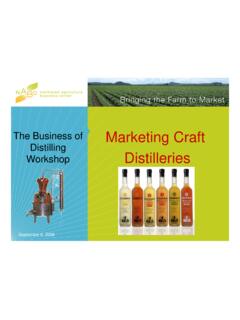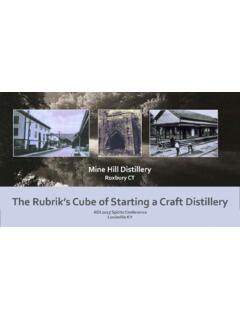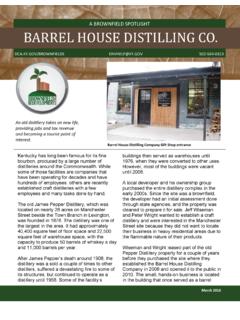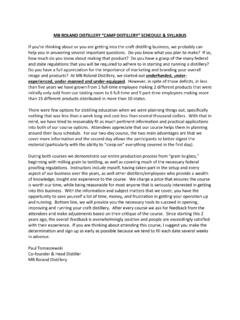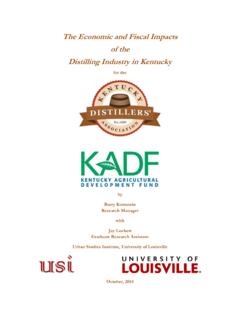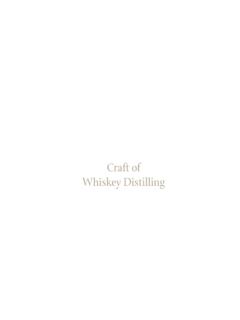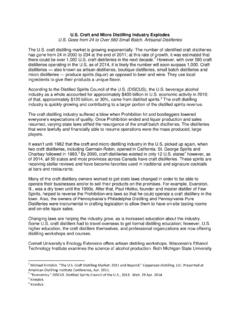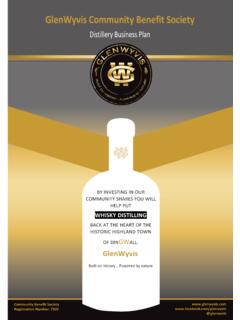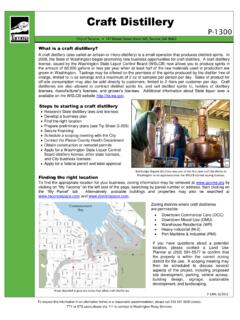Transcription of Craft Distilling 2011 white paper - Coppersea
1 The Craft Distilling Market: 2011 and Beyond1 Michael Kinstlick, CEO, Coppersea Distilling , LLC This paper surveys the existing Craft Distillers, segmenting the market geographically, by product category, and by entry- type. It also analyzes growth trends in the Craft Distilling market to date, and compares those both to market resurgences in similar businesses ( Farm Wineries and Craft Breweries), and to the broader history of the Distilling industry. 1. Introduction The Craft Distillery industry in the United States is undergoing explosive growth right now. The number of identifiable Craft Distilleries in production has gone from 24 in 2000, to 52 in 2005, to 234 at year- end 2011 , and new entrants are showing up with regularity.
2 Often consolidation to a few large firms in an industry creates opportunities for new, smaller entrants to fill market niches and reach customers the large producers cannot2. The Craft Distilling market fits this pattern well. This paper will trace the growth of the Craft Distillers, provide summary statistics on the current market entrants, and put the ongoing Craft Distillery resurgence in the historical context of the Distilling industry in the United States. Should the Craft Distilling industry continue along its current growth trajectory, the number of firms in the market will likely grow to more than 1,000 over the next 10 years. 2. Craft Distilleries By Entry Year The Craft Distilling industry in the United States began in California in 1982 with the entry of two firms, Germain- Robin and Jaxon Keys Winery (also known as Jepson Spirits).
3 The following year St. George Spirits and Domaine Charbay, also both in California, joined them. As can be seen in the following chart, the number of new entrants was very low in the industry s early years, often with no entrants at all. Chart 1: New Entrants per Year This is also a common feature of new industries, as the industry form strives for recognition as a unique, distinct class of companies. As the form becomes more widely recognized, new entrants have a template and an identity to model. Often, there is a geographic component in the emergence of new industry forms, and the state- level regulatory issues in distilled spirits give this particular salience. It is no accident that the first four firms are all based within a hundred miles of each other in Northern California, one of the epicenters of the Food Revolution of the 1970s, and the founding place of the Craft Brewing industry 20 years prior (Anchor Steam).
4 The number of annual Craft Distillery entrants is still growing at a nearly exponential pace. The 2011 number is almost certainly low due to hidden entrants not in the available data sources, and the likely true number of 2011 entrants is closer to 55. When all the entrants by year are put together, we see the number of total market participants (Chart 2) also showing exponential growth. Chart 2: Total Entrants per Year 3. Craft Distilleries By State As mentioned above, markets often display a geographical component, with many entrants clustered in a particular geography, or entrants in one place influencing or impelling entrants in a nearby geography3. In the case of the Craft Distillers, state- level differences in licensing requirements may lead to a profusion of entrants in one state, and few or none in a state next door.
5 Generally, the entry of the first Craft Distillery in a state has lead quickly to more, and, although not the subject of this paper , favorable changes in licensing requirements have been trigger events in individual states. For example, in New York, where my firm, Coppersea Distilling , is setting up, the passage of the Farm Distillery Act in 2007 made it significantly easier to establish a distillery, and the number of New York Craft Distillers went from 5 in 2007 to over 20 in 2011 . Below (Chart 3) is the distribution of entrants by state as- of 2011 . Chart 3: Operating Craft Distilleries By State, 2011 California, the state of first entry, continues to be a leader in the market, as do the nearby states of Oregon and Washington.
6 Oregon was the 2nd state with a Craft Distillery, Clear Creek, which opened in 1987; and the strong handmade and locavore culture in the Pacific Northwest have proven fertile grounds for starting businesses such as Craft Distilleries. Washington s market has grown from its initial entrant in 2007 to 17 in 2011 . Other notable states include Texas, where Tito s Vodka (1997) was the sole entrant until 2007 and now has company. Colorado s market has grown smartly with Peach Street, Stranahan s and Leopold Brothers making an early mark. Tuthilltown, while not the first entrant in New York (several winery- distillers predate it) has been instrumental in lobbying for Farm Distillers, resulting in a raft of new entrants.
7 The upper Midwest states of Wisconsin, Michigan, and Ohio feature strongly as well. Also notable is the lagging behind of the Southern & Trans- Appalachian states considered to have strong roots in folk Distilling ( moonshining ). The reasons are many, but certainly the number of folk distillers making spirits with traditional methods as handed down orally for generations is vanishingly small, and now dwarfed by the number of urban and sub- urban hobbyists bootstrapping their way with 10- gallon stove- top stills. However, now that many of these states have gone from none to one to three or four entrants, I would expect their numbers to continue to grow as they have elsewhere. The bigger story, as seen in the progression in Chart 4 is that in 2000 only 12 states had operating Craft Distilleries; today Craft Distilleries are operating in 45 states, making this a truly national phenomenon.
8 Chart 4: Operating Craft Distilleries By State, 1990- 4. Craft Distilleries By Product Type & Entry Path Craft Distillers are making an incredible variety of distilled spirits products. For the purposes of this analysis, I segmented the market into five major product categories: 1990 2000 2005 2010 Vodka, Gin, Whiskey, Rum, and Brandy/Other; this last includes Eau de Vies, Cordials, Liqueurs, and a profusion of unique, specialist products. Indeed, one of the aspects of an industry revival is the emergence of specialized producers amidst the flowering of new entrants. Included in these are Craft Distilleries offering products such as Limoncello (HelloCello, CA), Asian- Pear- based Eau de Vies (Subarashii Kudamono, PA), and Arak & Ouzo (Bear and Eagle Products, CA).
9 Even traditional categories, such as Vodka, are seeing not just, for example, organic producers (of which there are several), but also unusual sources such as a honey- based product ( Bee Vodka from Hidden Marsh, NY). While there are generalist entrants such as Leopold Brothers in Colorado or Triple Eight in Massachusetts with products across all five categories, almost half (46%) of the current entrants are single- category firms (see Chart 5). Another 40% are making products in 2 or 3 categories with the remaining 14% producing a wider range of products. This summary, however, obscures the underlying trend, which is that more of the newer entrants are single- category ( Monoline ) firms. In fact, two of every three of the 2011 entrants were single- category entrants, but as these firms mature some will also move into multiple categories.
10 Chart 5: Craft Distilleries By Product Category #s By Entry Year Many Craft Distillers make Vodka: it is easy and straightforward to make, requires no aging, and remains the single largest spirits category by case- volumes. More than half of Craft Distilleries are producing and selling Vodka, and this percentage is consistent across entry years. About 30% of all Craft Distilleries produce Gin. Also un- aged, but with more opportunities for the distiller to impart unique flavor profiles, Gin has seen a slight decline over time in the percentage of Craft Distillers devoting energy to this category. Of course, the number of Craft Distillers making Gin has almost trebled since 2006. Rum has held fairly steady as a product category through time, with about 25% of Craft Distilleries in this category.
